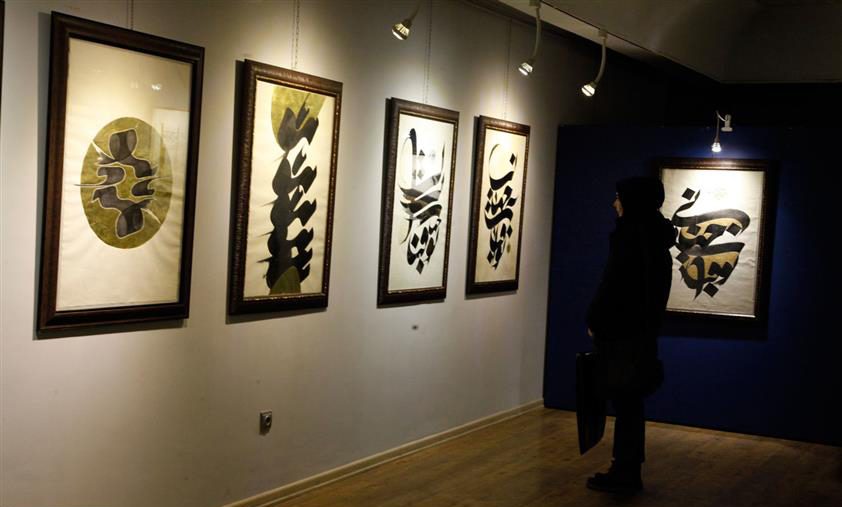Artworks by Spanish calligrapher, Nuria Garcia Masip, were displayed at Rezvan Gallery in Mashhad, Khorasan Razavi Province, on the occasion of Vahdat (Islamic Unity) Week.
The expo (Dec.26-Dec 31) also included calligraphy works by Nuria’s husband, Bahman Panahi, and drew large crowds.
Around 20 calligraphy works, including ‘Nasta’liq’, ‘Shikasta Nasta’liq’, ‘Naskh’, ‘Thuluth’ and ‘Calligram’ styles centering on Iranian poems mainly by Mawlana (Rumi) and verses from the holy Qur’an, along with a collection of Iranian traditional calligraphy, were displayed.
This is Nuria’s second expo in Iran with her husband, which saw a warm reception by the people. She hopes to further expand her interaction with Iranian artists, IRNA reported.
On the status of calligraphy in the modern world, she bemoaned the fact that this traditional art form has been marginalized ever since printing technology emerged.
To stop its extinction, Nuria said calligraphy has to find its way into people’s everyday life and they must see and identify with the art.
Nuria is the first non-Iranian Muslim woman to embrace the Iranian style of calligraphy and practice it in non-Islamic countries. She has frequently beaten male calligraphers in competitions to win the title of the most honorable calligrapher in the world.
Born in Ibiza, Spain, into a Muslim family, Nuria, 37, found her interest in Islamic Art and calligraphy in Morocco where she trained in the ‘Maghrebi’ script with Master Hamidi Bel’Aid. She further pursued her studies in the ‘Rika’, ‘Thuluth’, and ‘Naskh’ scripts with calligrapher Mohamed Zakariya in the United States and later in Istanbul, Turkey, with the great masters Hasan Celebi and Davut Bektas.
In 2007, she received her calligraphy diploma (Ijazah) in the ‘Thuluth’ and ‘Naskh’ scripts, under the auspices of IRCICA (Research Center for Islamic History, Art and Culture).
Prestigious Prizes
Nuria currently lives in Paris where she teaches and works on calligraphy. She has won prestigious prizes in international competitions, has conducted workshops and conferences in many countries and continues to exhibit her art internationally.
Bahman Panahi, 48, was born in Behshahr, Mazandaran Province. He has a PHD in visual arts and has been taught by prominent calligraphy masters. He specializes in ‘Nasta’liq’, ‘Shikasta Nasta’liq’ and ‘Calligram’.
Calligraphy is a visual art related to writing. It is the design and execution of lettering with a broad tip instrument, dip pen, or brush, among other writing instruments. A contemporary calligraphic practice can be defined as, “the art of giving form to signs in an expressive, harmonious, and skillful manner.”
Modern calligraphy ranges from functional inscriptions and designs to fine-art pieces where the letters may or may not be readable.
The history of calligraphy in Persia dates back to the pre-Islam era. In Zoroastrianism beautiful and clear writings were always praised.
It is believed that ancient Persian script was invented by about 600–500 BC to provide monument inscriptions for the Achaemenid kings. The scripts consisted of horizontal, vertical, and diagonal nail-shape letters, which is why it is called “script of nails/cuneiform script” (khat-e-mikhi) in Persian. Centuries later, other scripts such as “Pahlavi” and “Avestan” were used in ancient Persia.
Nasta’liq is the most popular contemporary style among classical Persian calligraphy scripts; Persian calligraphers call it the “bride of calligraphy scripts”. The main traditional calligraphy instrument is Iran is a chisel tipped bamboo straw which is pressed against special fiber soaked in ink to leave marks on the paper.


